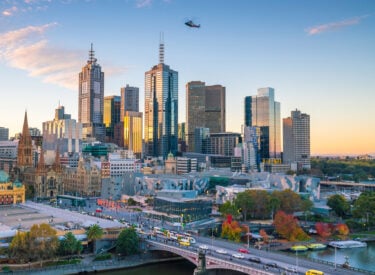
Key takeaways
Victoria's high property taxes, soaring state debt, and mandated improvements have increased compliance costs, increased maintenance costs, and reduced the amount of control investors have over their valuable assets. However, the long-term fundamentals of supply and demand will eventually overrule short-term sentiment.
Unlike Sydney, Melbourne has room to expand, and consequently doesn't have the same large disparity in property prices between inner-blue-chip suburbs and outer suburbs that Sydney does. However, with Melbourne's population projected to surpass Sydney's by 2036, infrastructure development will struggle to keep pace.
Melbourne's property prices have underperformed relative to other cities over the past 5 years, but are currently offering its best value in years when measured against Sydney. Given the principle of mean reversion in market cycles, it's reasonable to expect that Melbourne property prices will eventually rebound.
In November 2018, I hosted an investment briefing where I presented what I thought to be a compelling thesis on why the Brisbane property market was poised for significant growth.
Brisbane’s median house price has since surged by an impressive average annual rate of 9.96% over the 5 years from 2019 to 2023.
Consequently, the median house price is 60% higher than it was at the beginning of 2019.
Similarly, in August 2023, I concluded that Perth was on the cusp of a growth cycle.
This prediction has been vindicated by the latest data from CoreLogic’s daily price index, which indicates Perth’s median house price has risen by over 20% in the past 12 months.
I present these reminders not as a means of patting myself on the back, but to illustrate a fundamental principle: investment returns tend to revert to the mean over time.
Applying this analytical approach, my current forecast is that Melbourne is poised to deliver the highest dollar-value capital growth over the next decade.
Below, I outline the reasons underpinning this prediction.

What is driving negativity sentiment?
Over recent years, investor sentiment towards the Melbourne property market has soured, driven by stricter tenancy laws, increased taxation, and growing concerns about the state’s escalating debt (thanks Dan!).
In both 2015 and 2021, the Victorian government implemented stricter tenancy regulations.
While it’s essential to safeguard tenants from unfair landlords, these regulations have certainly increased compliance costs, increased maintenance costs as improvements are mandated in certain situations, and reduced the amount of control investors have over their valuable assets.
Over the past few years, Victoria has introduced a host of new property taxes including the COVID-19 Debt Temporary Land Tax Surcharge, windfall gains tax, Absentee Owner Surcharge, and Vacant Residential Land Tax, amongst others.
A report from the Parliament Budgetary Office highlighted that Victoria now imposes the highest property taxes nationwide.
Compounding this negative sentiment is Victoria’s soaring state debt, estimated at $126 billion.
Rating agency S&P has cautioned that this debt could nearly double by 2027.
Given this fiscal strain and the state’s heavy reliance on property tax revenue, investors are understandably concerned.
However, while these negative factors do increase property investment costs, their financial impact may already be fully reflected in current property prices.
Moreover, in the long run, fundamentals of supply and demand will eventually overrule short-term sentiment.
Melbourne’s sprawling suburbs
Unlike Sydney, which is constrained by its geographical boundaries of water and national parks, Melbourne has room to expand (spread out) to accommodate the increased population.
Consequently, Melbourne doesn’t have the same large disparity in property prices between inner-blue-chip suburbs and outer suburbs that Sydney does.
This geographical difference might lead some investors to mistakenly believe that Melbourne’s outer suburbs offer comparable investment prospects to its inner blue-chip areas because the price differential isn’t as large.
However, with Melbourne’s population projected to surpass Sydney’s by 2036, infrastructure development will struggle to keep pace.
Particularly considering how long it takes the government to build it and how much it ultimately costs!
As a result, due to congestion, travel times and lower amenities, outer suburbs will become less attractive to live in over the next few decades compared to blue-chip suburbs.
In my view, blue-chip property prices are relatively good value when compared to property prices in the outer suburbs.
Melbourne is cheap relative to other cities
The chart below compares Melbourne’s median house prices to Sydney, Brisbane, Adelaide, and Perth since 1980.
It illustrates how much Melbourne property prices have underperformed over the past 5 years.

When comparing Melbourne’s median property value to that of Brisbane, Adelaide, and Perth, the current relative value isn’t as depressed as it was between 2006 and 2008, as highlighted in the red rectangle.
This could suggest that Melbourne might continue to underperform over the next 1 to 3 years.
However, when measured against Sydney, a city with more comparable market dynamics, Melbourne is currently offering its best value in years.
To put it into perspective, Melbourne’s median house price is now equivalent to 57% of Sydney’s median price.
The only time Melbourne’s relative price was lower than this was back in 1981, at 56% of Sydney’s median.
This comparative analysis underscores that Melbourne’s property prices are currently at an unusually low point.
Given the principle of mean reversion in market cycles, it’s reasonable to expect that Melbourne’s property prices will eventually rebound.
This presents a compelling investment opportunity.
The past 3 to 5 years have been relatively poor for Melbourne
Over the past 3 to 5 years, Sydney, Brisbane, Adelaide, and to a lesser extent, Canberra have all boomed.
However, Melbourne has underperformed relative to all capital cities as illustrated in the recently updated chart below.

This chart clearly demonstrates that property markets tend to move in two distinct cycles.
A flat cycle is always followed by a growth cycle. In the long run, growth rates revert to their mean of circa 7.5% p.a.
This suggests that the average growth rate over the next 10 years in Melbourne is likely to be above average, as I have discussed here.
You fund retirement in dollars, not percentages
I’ve previously discussed the Perth property market, suggesting it’s poised for a significant growth cycle following a stagnant 15-year period.
I believe there’s a strong possibility that Perth’s median property price could nearly double over the next decade.
While Perth has already begun to see price growth, I think there’s substantial potential for further appreciation.
As a result, in terms of percentage growth, Perth may outpace Melbourne.
However, when considering absolute dollar returns, I anticipate Melbourne will deliver the most substantial growth over the next decade, primarily due to its higher starting property values.
According to the REIA, Melbourne’s median house price was $909,000 as of December 2023, compared to Perth’s $645,000.
When planning for retirement, it’s the dollar value return that holds the utmost significance.
Therefore, Melbourne’s higher initial property values suggest it could offer superior dollar-based growth opportunities for investors.
In addition, it is my view the Melbourne market is a lower-risk investment given its larger and more diverse population.
Apartments will also be long for the ride
In March 2024, I shared my thesis why I believe Melbourne’s investment-grade apartments are intrinsically undervalued and likely to yield attractive investment returns over the next decade.
The relative value of Melbourne, as discussed above, only adds weight to this thesis.

What will you think in 2034?
In 2034, a decade from now, I’m confident we’ll view property prices in Melbourne’s blue-chip suburbs from 2024 and 2025 as relatively cheap.
While investment sentiment is currently subdued, I expect it to shift in the next 1 to 3 years.
It’s challenging to pinpoint the exact timing of this sentiment reversal, but historically, market lows often coincide with the peak of negative sentiment – something I believe we’re experiencing now.
Given Melbourne’s relatively balanced property market, with an even level of demand from buyers and sellers, acquiring a property at fair market value is easier to do today compared to more buoyant markets.
However, the main challenge in identifying the right property is a process that can take several months or even more than a year.
Considering these factors, there’s little reason to postpone investing in Melbourne.
You risk ‘missing the boat’ if you wait for sentiment to improve.
While investing in Melbourne might not yield significant short-term returns over the next 1 to 3 years, selecting a high-quality, investment-grade property today, I have high confidence that you will be very pleased with the returns over the next decade.














